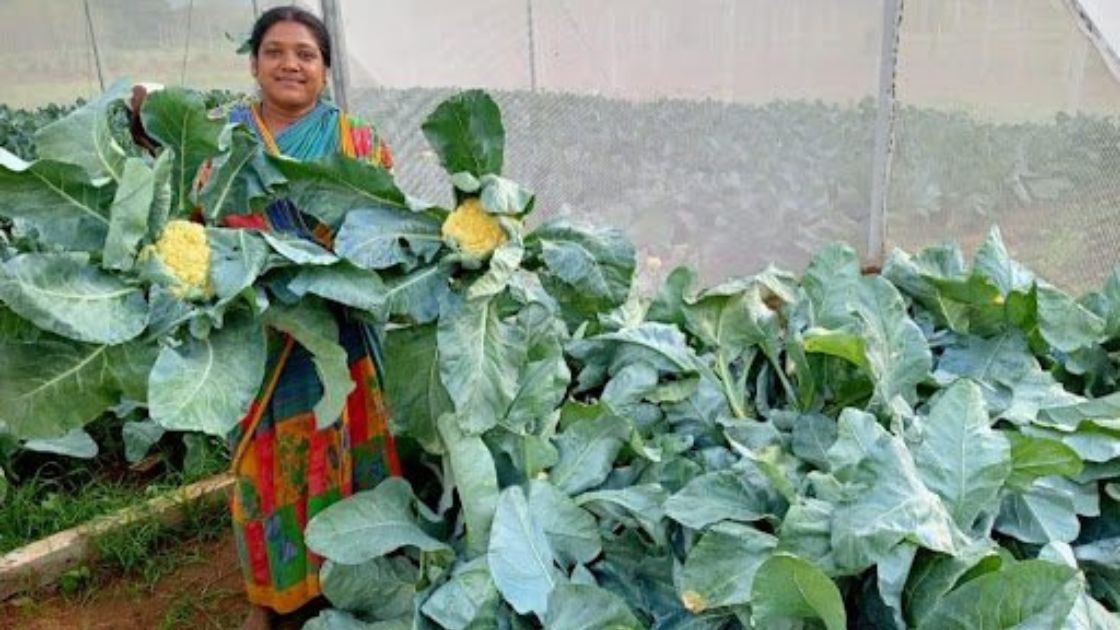Ampi Devi is a farmer in the Jharkhand town of Dumka. Ampi’s 2-acre farm had never provided enough food for her family. Her husband would work for a living in nearby towns, while Ampi would care for their family and the farm. Their savings from farming were around $300 / year.
Ampi purchased and installed a Kheyti Rakshak greenhouse on 1/10th acre of land last year. According to Ampi, “I began using the Kheyti Rakshak by sowing cauliflower, shortly after which we experienced unexpected heavy rains.” All of the crops in my open field were damaged by rain, but my crop inside the greenhouse produced the highest yields I have ever seen! I harvested approximately 5,000 kg of cauliflower in three months and earned $800 from one crop! I am feeling more empowered now, and I would like to expand this green house to at least half an acre. “I want to use the greenhouse profits to pay for my children’s college education.”
Ampi’s family saw a 2.5x income increase in just 3 months.
Ampi is just one of many examples of the potential of our solution, the Kheyti Greenhouse-in-a-Box, which is a low-cost greenhouse designed for Indian smallholder farmers.
Climate change is disproportionately affecting smallholder farmers, the people who produce the food we eat. India alone has 100 million smallholder farmers. All of our previous interventions will not be sufficient for farmers to adapt to the environment in ten years. We must ensure that every smallholder farmer has access to a portfolio of climate smart solutions that will assist them in mitigating and adapting to climate change. Kheyti’s goal is to accelerate that vision. Our current solution assists smallholder farmers in doubling their earnings, adapting to climate change, and growing more sustainably.
Over the past five years, we have demonstrated that high-tech solutions such as greenhouses can be made to work for smallholder farmers. We listened to farmers like Ampi and iterated the solution seven times to make it (1) low-cost (90% less than the market) (2) modular – farmers can begin small and gradually expand; (3) local – designed for local crops; and (4) holistic – bundled a service package with the greenhouse to ensure easy adoption. We have now replicated this model in ten Indian states and scaled it to over 3,000 farmers.
Our goal over the next five years is to make this work for one million or more farmers. Over the next five years, we hope to reach a critical mass of 100,000 farmers and standardize the recipe for replication so that more companies can come in and create a market. We also hope to persuade the Indian government to develop a national policy on small greenhouses that reaches the smallest farmers, such as Ampi Devi.
I left my comfortable investment banking job 12 years ago to try to make a dent in the daunting problem of rural poverty. Initially, the challenge I had taken on seemed too daunting, and I had to persevere solely on faith. The motivation now comes from a different source. It comes from Ampi’s story, which is not about Kheyti but about hard work, perseverance, and resilience in the face of adversity caused by climate change. Her success, as well as the success of so many other farmers like hers, demonstrate to me that it is possible to develop models that are impactful, sustainable, and scalable.
We cannot solve the big challenges of rural poverty or climate change alone. My dream is that our success not only scales directly to millions of farmers, but inspires 1,000s of individuals and organizations like Kheyti to serve farmers like Ampi – only then can we ignite a smart farmer revolution.


